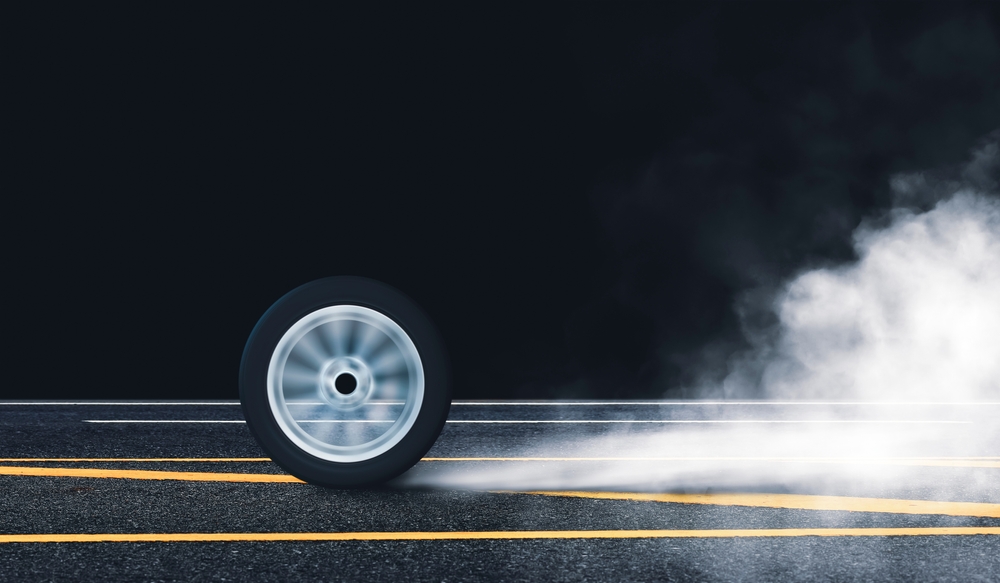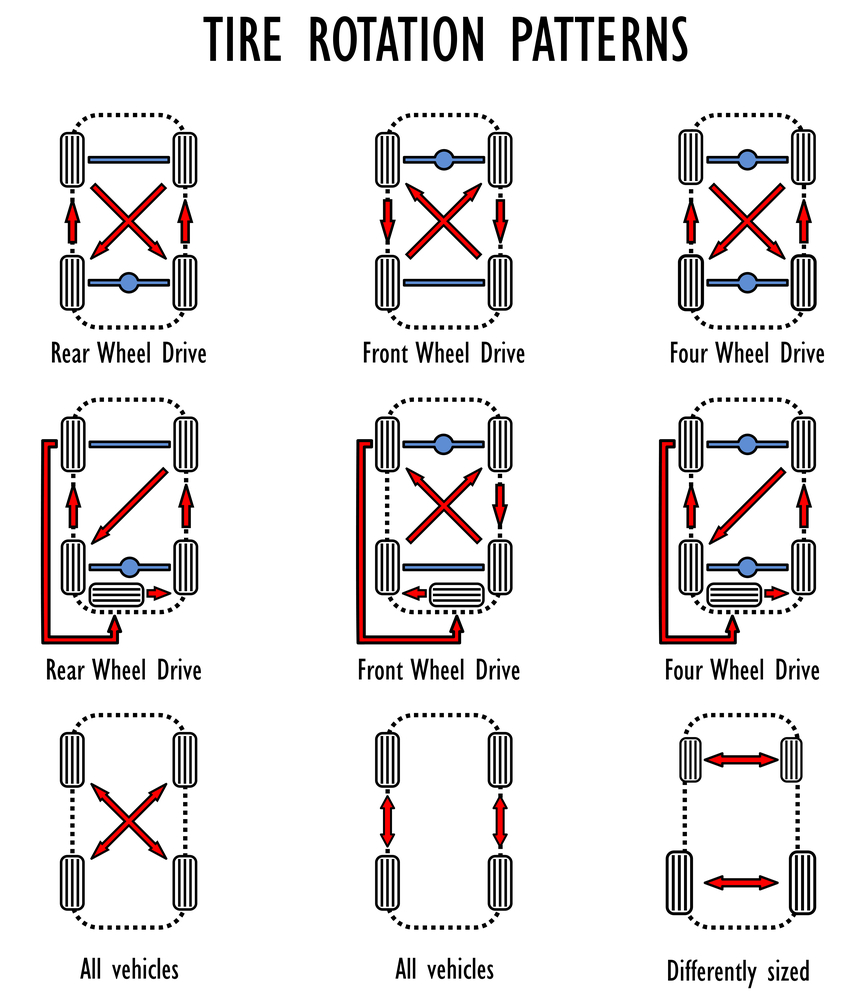How Often Should You Rotate Your Tyres? Your Guide to Maximise Tyre Lifespan

Ever noticed that some of your tyres wear out faster than others? That’s because not all tyres experience the same amount of pressure and friction. Regular tyre rotation helps maintain even tread wear, improves tyre lifespan, and enhances driving safety.
But how often should you do it? Let’s break it down.
What is Tyre Rotation? Why it Matters?
Tyre rotation is an essential maintenance step that involves changing the position of your tyres; usually moving them from front to back or side to side.
But why does it matter? Because tyres don’t wear out evenly. The tyres connected to your car’s drive axle experience the most friction and wear down the fastest. In front-wheel-drive cars, the front tyres take most of the impact. Whereas, in rear-wheel-drive vehicles, it’s the back tyres that wear out quicker.
By rotating your tyres regularly, you ensure they wear evenly, last longer, and provide better traction. This saves you money and keeps you safer on the road as well.
How Often Should You Rotate Your Tyres?
You should rotate your car tyres every 8,000 to 10,000 km or at least 6 six months to keep them in top condition, mostly aligning with your car’s regular service.
Other good times for a tyre rotation include:
- When switching between summer and winter tyres
- After buying new tyres to maximise their lifespan
- If you notice uneven tread wear
If you’re replacing only two tyres, we recommend fitting the new or least worn ones to the rear axle. This improves vehicle stability and control. No matter if you drive a front-wheel, rear-wheel, or all-wheel-drive car. And don’t forget to check and adjust tyre pressure after a rotation for optimal performance.
Factors Affecting Tyre Rotation Frequency
Regular tyre rotation helps extend tyre life and keeps your car running safely. But how often to do it depends on several factors, including your driving style, vehicle type, and road conditions. Here’s what affects tyre wear and when you should rotate them.
Your Driving Habits Matter
How you drive plays a big role in how quickly your tyres wear out. If you frequently brake hard, accelerate fast, or take sharp turns, your tyres will wear unevenly. Especially the ones carrying most of your vehicle’s weight.
Driving on rough, unpaved roads also speeds up tyre wear compared to smooth city streets or highways. If your daily commute includes bumpy roads, your tyres will need rotation more often.
Your Vehicle’s Drivetrain (FWD, RWD, 4WD)
Not all tyres wear out at the same rate, and your vehicle’s drivetrain plays a big part in that:
- Front-Wheel Drive (FWD): The front tyres do most of the work. So, they wear out faster.
- Rear-Wheel Drive (RWD): The rear tyres handle more power and torque which leads to quicker wear at the back.
- All-Wheel Drive (AWD/4WD): Wear is more evenly spread across all four tyres. But rotation is still important to prevent alignment issues and ensure even wear.
Rotating your tyres at the right time helps balance out this wear and keeps your car handling smoothly.
Vehicle Load & Weight Distribution
The heavier your load, the harder your tyres work. Carrying heavy tools, passengers, or towing a trailer puts extra pressure on certain tyres, usually the rear ones, leading to faster wear.
Other weight-related factors include:
- Engine Position: Most cars have front-mounted engines which means the front tyres bear more weight and wear down faster.
- Braking Pressure: The front tyres take most of the force when braking. This causes them to wear out quicker.
- Wheel Alignment Issues: If your wheels aren’t aligned properly, some tyres will wear out unevenly. This makes regular rotation even more important.
6 Common Signs It’s Time to Rotate Your Tyres
Keeping up with regular tyre rotation helps extend their lifespan. But sometimes, unexpected issues pop up. Not sure if it’s time? Look out for these common signs:
Uneven Tread Wear
Noticing that one tyre looks more worn than the others? This is a major red flag.
Uneven tread wear means your tyres aren’t wearing evenly. This can affect your car’s stability and safety. A timely rotation can help. But if the wear is severe, a replacement would be necessary.
Your Car Feels Off-Balance (Pulling or Vibrations)
If your steering wheel shakes or your car pulls to one side, your tyres could be wearing unevenly. This mostly happens due to misalignment. But pairing a tyre rotation with a professional wheel alignment can fix the problem and give you a smoother ride.
You’ve Hit the 10,000 km Mark
Haven’t rotated your tyres in the last 10,000 km or 6 months? It’s time. Regular rotation helps prevent excessive wear and keeps your tyres performing at their best.
Strange Noises While Driving
Hearing a weird humming or droning noise? That could be your tyres telling you they’re wearing unevenly. Regular rotations keep noise levels down, making your drives smoother and quieter.
Uneven Tyre Pressure
If one tyre consistently loses air faster than the others, it could be due to uneven wear. Getting your tyres rotated can help balance out the pressure across all four wheels.
Your Fuel Economy Has Dropped
Worn or uneven tyres create extra resistance which makes your engine work harder and burning more fuel. If you’ve noticed a drop in fuel efficiency, a tyre rotation might be the simple fix you need.
Different Tyre Rotation Patterns | Which One is Right for Your Car?
Depending on your vehicle type and drivetrain, different tyre rotation patterns work best:
Drivetrain / Tyre Type | Rotation Pattern | How It Works | Best For |
Rear-Wheel Drive (RWD) | Rearward Cross | · Rear tyres move straight to the front. · Front tyres cross diagonally to the rear. | Sedans, SUVs, RWD trucks |
Front-Wheel Drive (FWD) | Forward Cross | · Front tyres move straight to the rear. · Rear tyres cross diagonally to the front. | Most passenger cars, hatchbacks, FWD SUVs |
Four-Wheel Drive (4WD) / AWD | X-Pattern or Rearward Cross | · Rear tyres move to the front. · Front tyres cross diagonally to the rear. | 4x4s, AWD vehicles, off-road trucks |
All Vehicles (Alternative) | X-Pattern | · All tyres swap diagonally. | Any vehicle with uniform tyre sizes |
All Vehicles (Alternative) | Front-to-Rear | · Front tyres move straight to the rear and vice versa. | Vehicles with non-directional tyres |
Staggered Tyre Sizes (Front and rear tyres are different sizes) | Side-to-Side | · Left tyres swap with right tyres (no front-to-back movement). | Performance cars, sports cars with different front/rear tyre sizes |
Directional Tyres (Tyres designed to rotate in one direction) | Front-to-Rear Only | · Front tyres move straight to the rear and vice versa (must stay on the same side). | High-performance cars, sports vehicles |
If you’re unsure which pattern is right for your vehicle tyres, check your owner’s manual or ask a professional tyre service.
Need a quick and reliable tyre rotation in Perth?
Don’t Ignore the Signs | Get Your Tyres Rotated Today
At Wangara Tyre Auto, we offer expert tyre services to keep your car running smoothly. If you’ve noticed uneven wear, pulling, or unusual road noise, don’t wait. Get it checked today. Whether it’s a tyre rotation, wheel alignment, or puncture repair, we’ve got you covered.
Need new tyres? We stock a wide range of high-quality tyres for 4x4s, and trucks, all sourced from top tyre brands in Perth.

